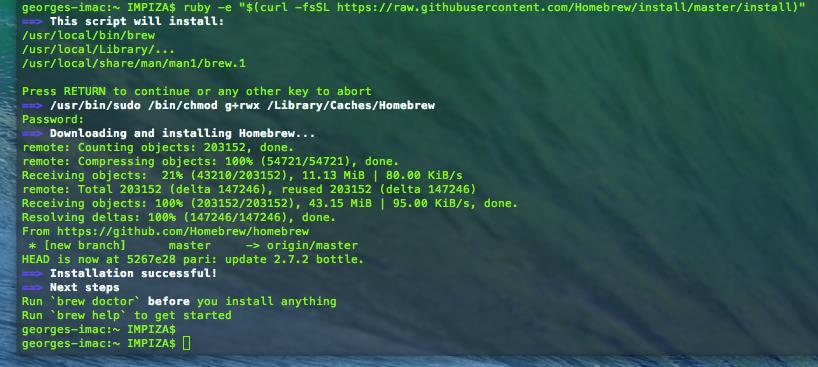

- #GET HOMEBREW FOR MAC INSTALL#
- #GET HOMEBREW FOR MAC SOFTWARE#
- #GET HOMEBREW FOR MAC PASSWORD#
- #GET HOMEBREW FOR MAC WINDOWS#
When Xcode finishes, this command will install Homebrew: $ ruby -e "$(curl -fsSL )"
#GET HOMEBREW FOR MAC PASSWORD#
This will probably ask for your password and may take awhile depending on whether you already have any Xcode components installed already. Installing Homebrewįirst, we’ll install a bit of Apple’s Xcode, which Homebrew requires, and then Homebrew. If you don’t see something like that and instead Bash says -bash: brew: command not found, then you need to install Homebrew. Open a terminal and find out whether it is installed by checking the version: $ brew -version Homebrew 2.2.14 Homebrew/homebrew-core (git revision 118be0 last commit ) Homebrew/homebrew-cask (git revision 656ce last commit ) Since we’re using Homebrew, or brew, to keep Python up-to-date, it needs to be installed. We’ll need to see where you’re starting from in order to get setup correctly.
#GET HOMEBREW FOR MAC SOFTWARE#
If you’re setting up your Mac from scratch, my article Zero to Hero: Set Up Your Mac for Software Development will guide you through the whole process. However, if you require nuanced versioning or multiple versions of Python, check out my article on pyenv: Multiple version Python development on Mac. This is a good one-size-fits-all solution. If you do not yourself have admin privileges, consider asking your admin staff to create a linuxbrew role account for you with home directory set to /home/linuxbrew.įollow the Next steps instructions to add Homebrew to your PATH and to your bash shell profile script, either ~/.profile on Debian/Ubuntu or ~/.bash_profile on CentOS/Fedora/Red Hat.NOTE: In this opinionated story, I suggest that the “right” way of doing Python 3 on macOS is to have the latest version and to stay current with frequent updating. The prefix /home/linuxbrew/.linuxbrew was chosen so that users without admin access can ask an admin to create a linuxbrew role account and still benefit from precompiled binaries. If you decide to use another prefix: don’t open any issues, even if you think they are unrelated to your prefix choice. The main reason Homebrew just works is because we use bottles (binary packages) and most of these require using the default prefix. Building from source is slow, energy-inefficient, buggy and unsupported. Many things will need to be built from source outside the default prefix. However, you shouldn’t install outside the default, supported, best prefix. Technically, you can install Homebrew wherever you want. Using /home/linuxbrew/.linuxbrew allows the use of most binary packages (bottles) which will not work when installing in e.g. Homebrew does not use sudo after installation. The installation script installs Homebrew to /home/linuxbrew/.linuxbrew using sudo.

Instructions for the best, supported install of Homebrew on Linux are on the homepage.
#GET HOMEBREW FOR MAC WINDOWS#


Homebrew can install its own current versions of glibc and gcc for older distributions of Linux.įeatures, installation instructions and requirements are described below. Homebrew does not use any libraries provided by your host system, except glibc and gcc if they are new enough. Homebrew was formerly referred to as Linuxbrew when running on Linux or WSL. The Homebrew package manager may be used on Linux and Windows Subsystem for Linux (WSL) 2.


 0 kommentar(er)
0 kommentar(er)
